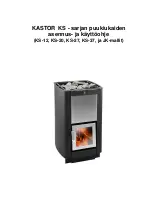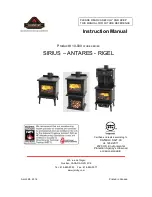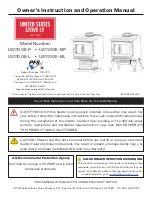
10
BENDS IN FLUES
Openings for inspection & cleaning should be formed using purpose factory-
made components compatible with the flue system, having an access cover
that has the same level of gas-tightness as the flue system and an equal level
of thermal insulation.
Offsets in flues are only acceptable if the following rules are respected:
a) The chimney system shall have no more than 4 bends in total; - 2 bends in
the chimney and 2 bends in the flue pipe connection.
b) The offset shall provide a change of direction no more than 45 degrees
from the vertical.
c) The run of the chimney between bends shall not exceed 20% of the total
chimney length.
d) the maximum length of the horizontal flue must not exceed 150mm (6”).
INSPECTION & CLEANING
Check that the chimney is in good condition, dry and free from cracks and
obstructions. The diameter of the chimney should not be less than 150mm
and not more than 230mm. If any of these requirements are not met, the
chimney should be lined by a suitable method.
The chimney must be swept before connection to the stove. Where the
chimney is believed to have previously served an open fire installation, it is
possible that the higher flue gas temperature from the stove may loosen
deposits that were previously firmly adhered, with the consequent risk of flue
blockage. It is therefore recommended that the chimney be swept a second
time within a month of regular use after installation.
Assuming that when the stove is first installed, the chimney is clean, and
sound, then the chimney flue should be inspected part way through the
burning season to establish the regularity of sweeping required. If you have
any doubts about the suitability of your chimney, consult your local dealer/
stockist.
If there is no existing chimney, then a prefabricated block chimney in
accordance with Building Regulations Approved Document J, or a twin-
walled insulated stainless steel flue to B.S.4543 can be used. These chimneys
must be fitted in accordance with the manufacturer’s instructions and
Building Regulations.
FLUE DRAUGHT
A flue draught of minimum 1.2mm to a maximum 2.5mm water gauge is
required for satisfactory stove performance. The flue draught should be
checked under fire at high output. If it exceeds the recommended
maximum, a draught stabiliser must be fitted so that the rate of burning can
be controlled to prevent over-firing. If the reading is less than the
recommended minimum the performance of the stove will be compromised.
Содержание PARLOUR
Страница 1: ...USER GUIDE GC0710 Classic Cast Iron Stove PARLOUR PART NO 6910085 ...
Страница 23: ...23 DECLARATION OF CONFORMITY ...
Страница 24: ......










































